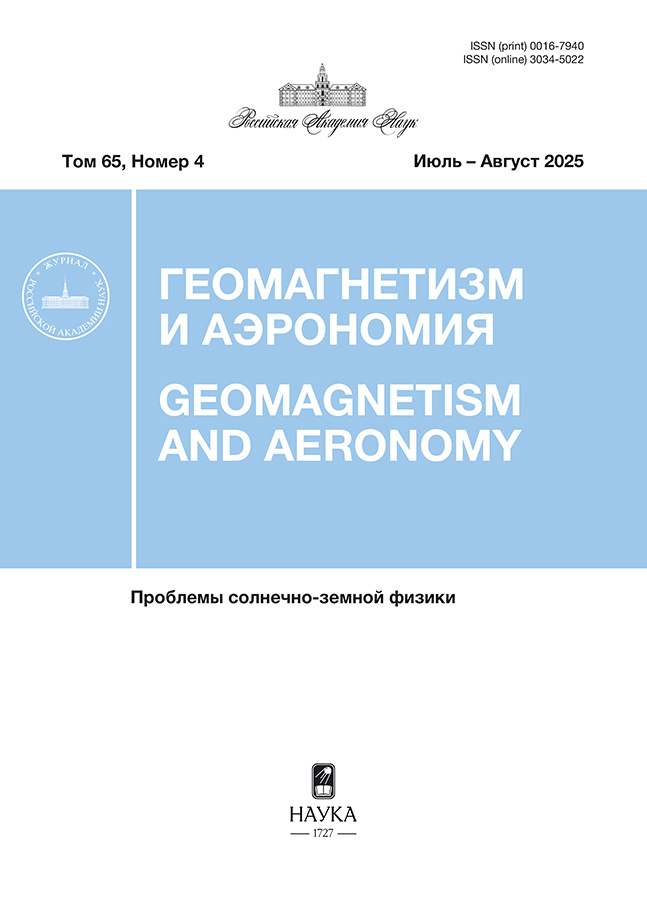Dependence of foF2 on Solar Activity Indices Based on the Data of Ionospheric Stations of the Northern and Southern Hemispheres
- Authors: Danilov A.D.1, Berbeneva N.A.2
-
Affiliations:
- Institute of Applied Geophysics
- Moscow State University
- Issue: Vol 64, No 2 (2024)
- Pages: 253-264
- Section: Articles
- URL: https://ruspoj.com/0016-7940/article/view/650944
- DOI: https://doi.org/10.31857/S0016794024020083
- EDN: https://elibrary.ru/DYQQRG
- ID: 650944
Cite item
Abstract
An analysis of the dependence of the F2-layer critical frequency on solar activity indices that has been started earlier based on the Juliusruh station data is continued. The data of six stations in the Northern Hemisphere and five stations in the Southern Hemisphere are analyzed in this paper. The determination coefficient R2 for the foF2 dependence on solar activity in each particular situation (station, month, local time) is taken as a measure of the quality of that dependence. The conclusion that a well-pronounced diurnal variation in R2 is observed in the winter months is confirmed for four solar activity proxies: this value is maximum and changes weakly in the daytime but decreases substantially to the nighttime hours. It is found that the F30 proxy is the best solar proxy to describe the foF2 behavior in the solar cycle, whereas the sunspot number Rz is the worst. Based on a comparison of the changes in R2 with LT in the same months at stations of the Northern and Southern hemispheres, it is shown that the aforementioned well-pronounced diurnal behavior in R2 is observed only in winter and is absent in summer
Full Text
About the authors
A. D. Danilov
Institute of Applied Geophysics
Author for correspondence.
Email: adanilov99@mail.ru
Russian Federation, Moscow
N. A. Berbeneva
Moscow State University
Email: adanilov99@mail.ru
Physical Faculty
Russian Federation, MoscowReferences
- Данилов А.Д., Бербенева Н.А. Статистический анализ зависимости критической частоты foF2 от различных индексов солнечной активности // Геомагнетизм и аэрономия. 2023. Т. 63. № 5. С. 610—629. https://doi.org/10.31857/S0016794023600588
- Данилов А.Д., Константинова А.В. Долговременные вариации параметров средней и верхней атмосферы и ионосферы (обзор) // Геомагнетизм и аэрономия. 2020. Т. 60. № 4. С. 411—435. https://doi.org/10.31857/S0016794020040045
- Кринберг И.А., Тащилин А.В. Ионосфера и плазмосфера. М.: Наука, 1984.
- de Haro Barbás B.F., Elias A.G. Effect of the inclusion of solar cycle 24 in the calculation of foF2 long-term trend for two Japanese ionospheric stations // Pure Appl. Geophys. 2020. V. 177. P. 1071—1078.
- de Haro Barbás D.F., Elias A.G., Fagre M., Zossi B.F. Incidence of solar cycle 24 in nighttime foF2 long-term trends for two Japanese ionospheric stations // Stud. Geophys. Geod. 2020. V. 64. P. 407—418. https://doi.org/10.1007/s11200-021-05489
- de Haro Barbás D.F., Elias A.G., Venchiarutti J.V., Fagre M.M., Zossi B.S., Jun G.T., Medina F.D. MgII as a solar proxy to filter F2-region ionospheric parameters // Pure Appl. Geophys. 2021. V. 178. P. 4605—4618.
- de Haro Barbás B.F., Zossi B.S., Jun G.T., et al. Performance of the IRI-2016 and IRI-Plas 2020 considering MgII as EUV solar proxy // Adv. Space Res. 2023. V. 72. № 6. P. 2406—2417. https://doi.org/10.1016/j.asr.2023.06.007
- Gulyaeva T.L., Arikan F., Sezen U., Poustovalova L.V. Eight proxy indices of solar activity for the International Reference Ionosphere and Plasmasphere model // J. Atmos. Sol.-Terr. Phy. 2018. V. 172. P. 122—128. https://doi.org/10.1016/j.jastp.2018.03.025
- Laštovička J. What is the optimum solar proxy for long-term ionospheric investigations? // Adv. Space Res. V. 67. № 1. P. 2—8. 2021a. https://doi.org/10.1016/j.asr.2020.07.025
- Laštovička J. The best solar activity proxy for long-term ionospheric investigations // Adv. Space Res. V. 68. P. 2354—2360. 2021b. https://doi.org/https://doi.org/10.1016/j.asr.2021.06.032
- Laštovička J. Long-term changes in ionospheric climate in terms of foF2 // Atmosphere. 2022. V. 13. № 1. P. 110. https://doi.org/10.3390/atmos13010110
- Laštovička J. Dependence of long-term trends in foF2 at middle latitudes on different solar activity proxies // Adv. Space Res. 2023. https://doi.org/10.1016/j.asr.2023.09.047
- Laštovička J., Burešová D. Relationships between foF2 and various solar activity proxies // Space Weather. 2023. V. 21. e2022SW003359. https://doi.org/10.1029/2022SW003359
- Lean J., Emmert J.T., Picone J.M., Meier P.R. Global and regional trends in ionospheric electron content // J. Geophys. Res. Space, 2011. V. 116. A00H04. https://doi.org/10.1029/2010JA016378
- Perna L., Pezzopane M. foF2 vs solar indices for the Rome station: looking for the best general relation which is able to describe the anomalous minimum between cycles 23 and 24 // J. Atmos. Sol.-Terr. Phy. 2016. V. 148. P. 13—21. https://doi.org/10.1016/j.jastp.2016.08.003
- Sivakandan M., Mielich J., Renkwitz T., Chau J.L., Jaen J., Laštovička J. Long-term variations and trends in the E, F and sporadic E (Es) layer over Juliusruh, Europe // J. Geophys. Res. — Space. 2022. V. 128. e2022JA031097. https://doi. org/10.1029/2022JA031097
- Zossi B.S., Medina F.D., Jun G.T., et al. Extending the analysis on the best solar activity proxy for long-term ionospheric investigations // Proc. Royal Society A. 2023. V. 479. № 2276. https://doi.org/10.1098/rspa.2023.0225
Supplementary files























